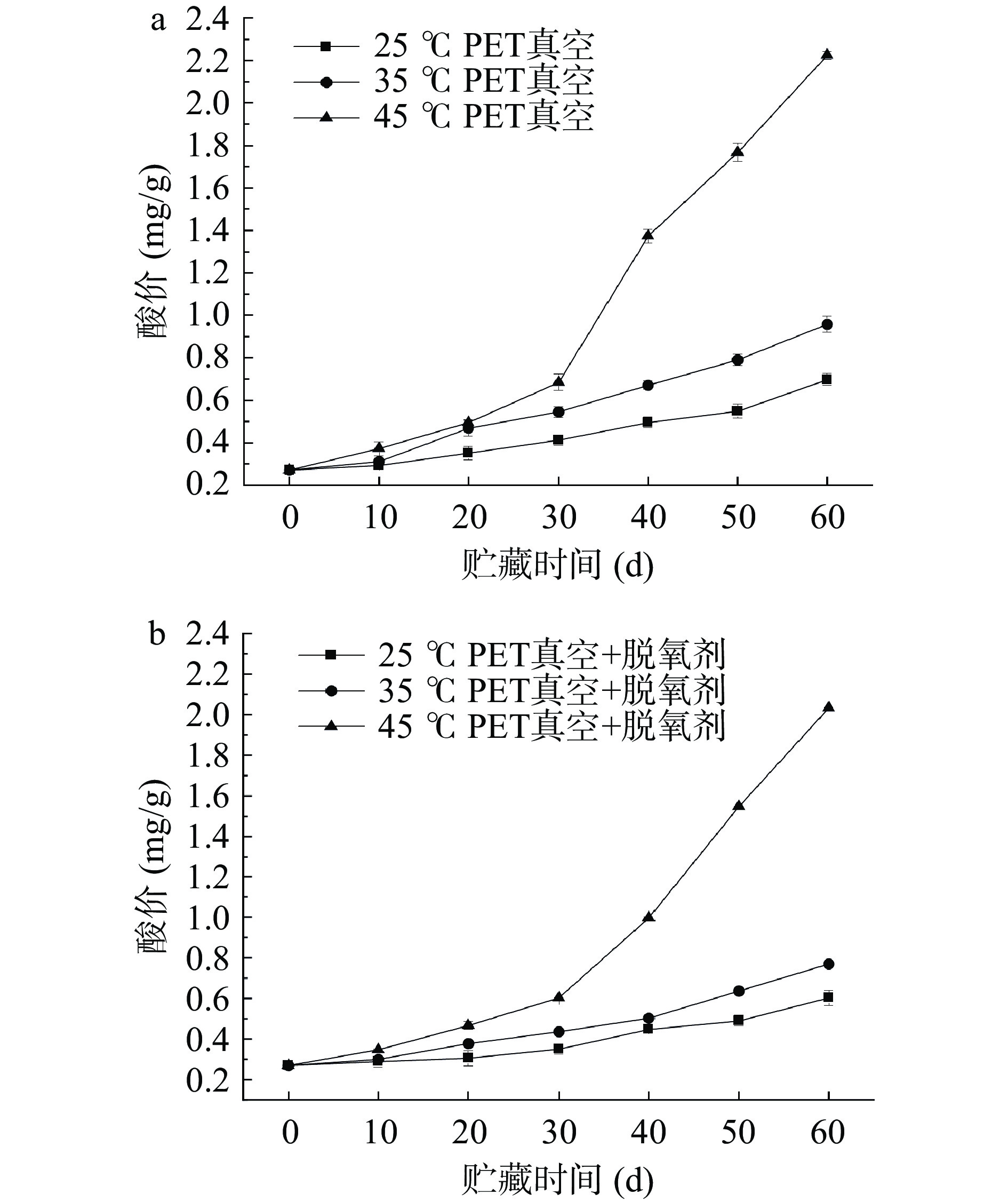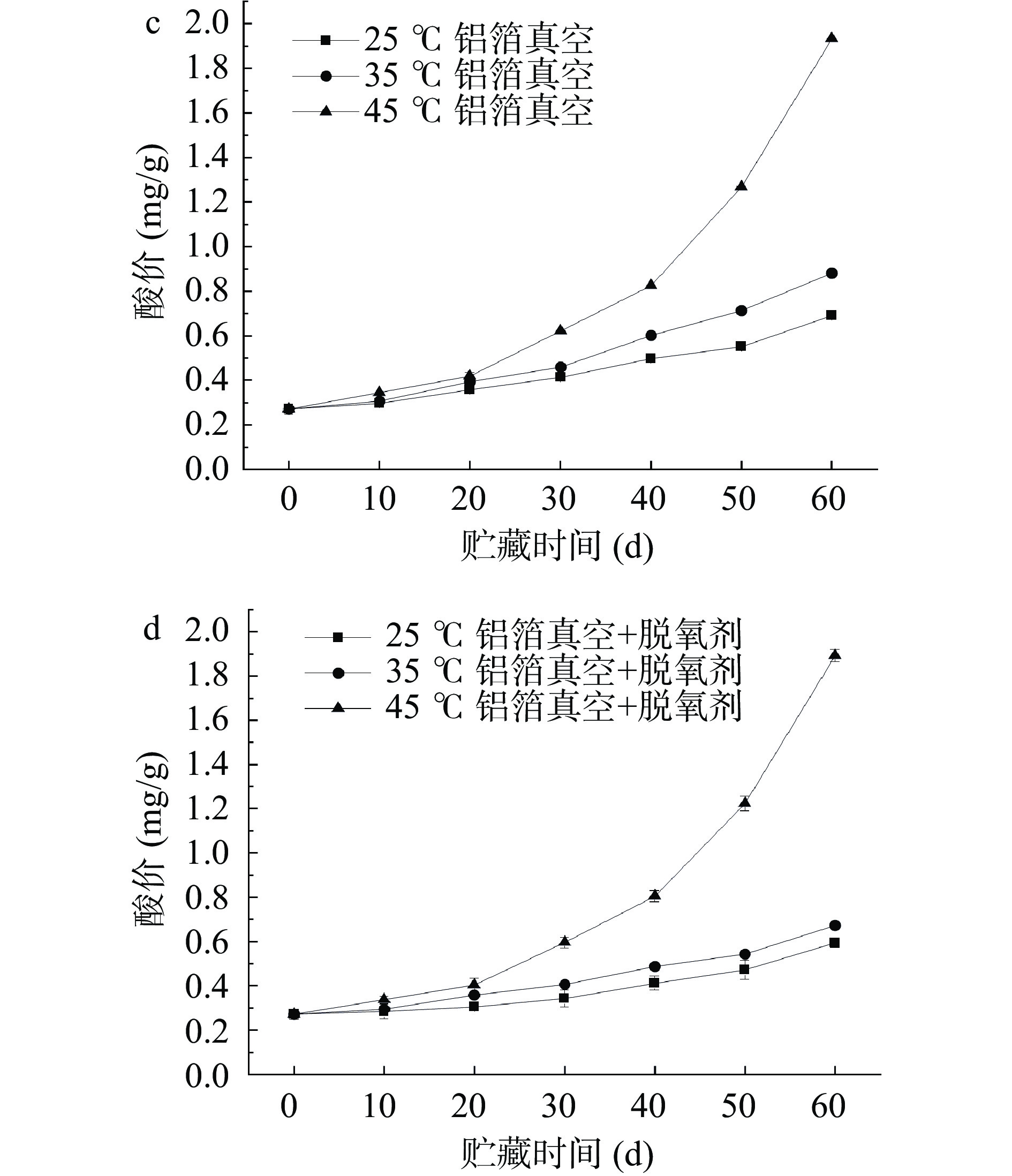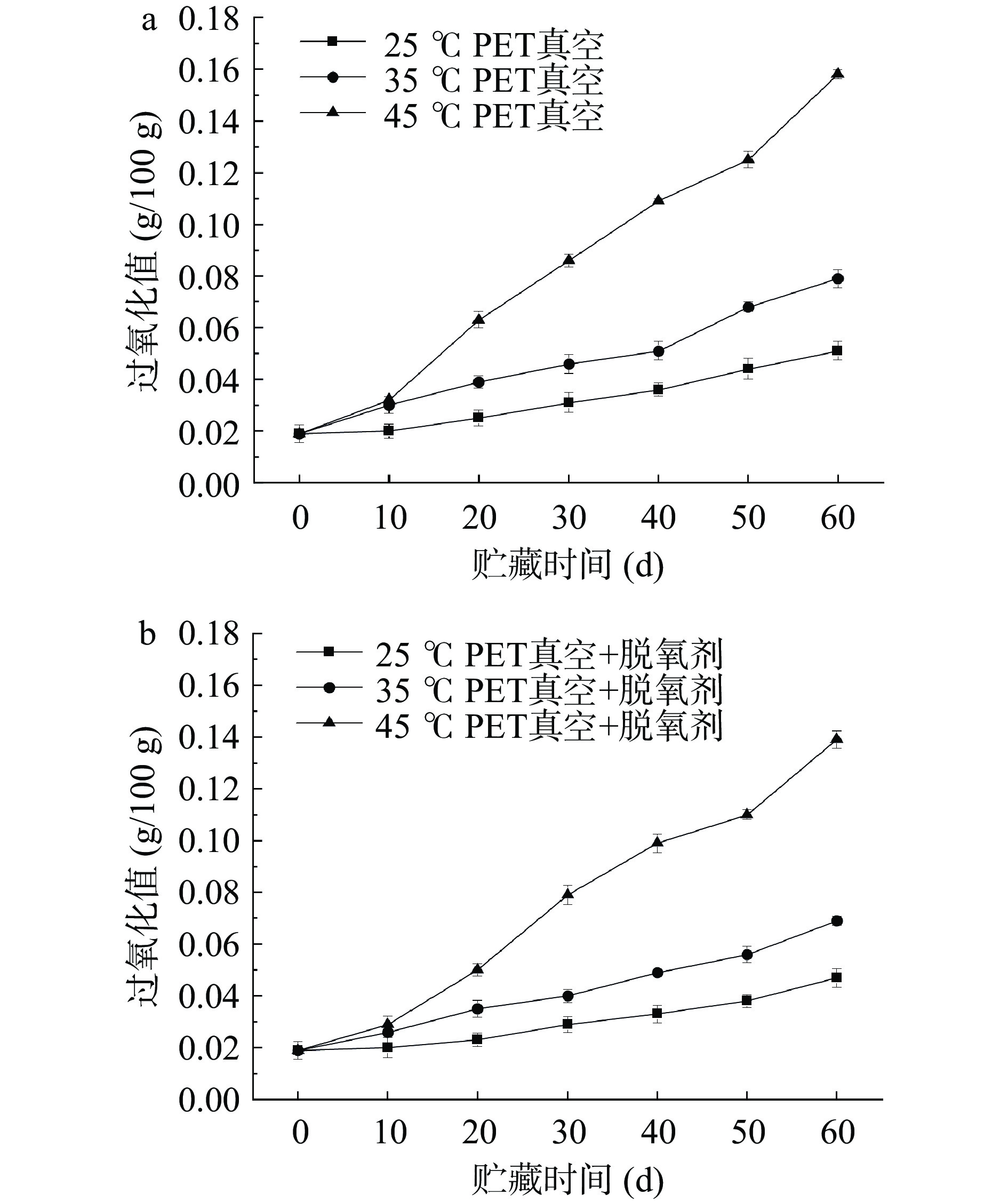Prediction of the Shelf Life of Fried Crispy Dates by Combining Two Packaging Materials with Vacuum Storage
-
摘要: 为探究低温油炸脆枣贮藏过程中品质劣变规律,采用PET真空包装、PET真空+脱氧剂包装、铝箔真空包装、铝箔真空+脱氧剂四种包装方式,分析不同贮藏温度(25、35、45 ℃)下酸价和过氧化值的变化,结合Arrhenius公式建立低温油炸脆枣货架期的预测模型。结果表明:不同贮藏温度下四种包装方式的油炸脆枣的酸价、过氧化值呈上升趋势,25 ℃变化速率低。从包装效果来看,铝箔真空+脱氧剂包装方式油炸脆枣的氧化速率最低(酸价动力学模型K值=0.0131,过氧化值动力学模型K值=0.0147),预测货架期模型R2>0.90,拟合度良好,货架期预测值模型误差小于10%。通过比较不同包装方式真空低温油炸脆枣的品质变化,铝箔真空+脱氧剂包装效果最佳,该包装方式下常温贮藏60 d,酸价上升了0.322 mg/g,过氧化值上升了0.026 g/100 g,预测货架期达180 d。Abstract: In order to investigate the deterioration of the quality of low-temperature fried crisp dates during storage, four packaging methods, including PET vacuum packaging, PET vacuum+deoxidiser packaging, aluminium foil vacuum packaging and aluminium foil vacuum+deoxidiser packaging, were used to analyse the changes of acid value and peroxide value at different storage temperatures (25, 35 and 45 ℃) and to establish a prediction model for the shelf life of low-temperature fried crisp dates by combining the Arrhenius formula. The results showed that the acid value and peroxide value of fried crispy dates in the four packaging methods showed an increasing trend at different storage temperatures, with a low rate of change at 25 ℃. In terms of packaging effect, the lowest oxidation rate was observed in the aluminium foil vacuum+deoxidiser packaging method (K value = 0.0131 for acid value kinetic model and K value=0.0147 for peroxide value kinetic model), and the R2 of the predicted shelf-life model was >0.90, with a good fit and the model error of the predicted shelf-life value was less than 10%. By comparing the quality changes of vacuum and low-temperature fried crispy dates in different packaging methods, the best result was obtained with the aluminium foil vacuum+deoxidiser packaging, which increased the acid value by 0.322 mg/g and peroxide value by 0.026 g/100 g for 60 days at room temperature, and the predicted shelf life reached 180 days.
-
Keywords:
- fried crispy dates /
- storage temperature /
- packaging method /
- acid value /
- peroxide value /
- kinetic model /
- shelf life
-
油炸食品具有酥脆的口感及浓郁的油脂香气,但随着贮藏时间的延长,油炸食品易发生品质劣变、影响其风味和营养价值[1]。货架期内油炸产品品质变化主要表现为油脂氧化酸败,酸价和过氧化值随贮藏时间增加[2-4],同时伴随产品颜色变差、硬度增加等现象[5-8]。油炸脆枣口感酥脆,具有油脂及枣本身独特的香气,但脆枣中油脂受温度、光照、包装方式等[9-12]因素的影响不断氧化,会使脆枣产生不愉快的气味,降低其食用价值,缩短食品货架期。
市面上油炸脆枣多以透明复合PE、PET、尼龙材料进行真空包装。陈锦豪[13]研究发现,使用高阻隔性塑料材料结合真空脱氧包装,可延长油炸花生在常温保存下的保质期。吕春茂等[14]通过测定普通包装、充氮包装、真空包装,三种包装方式在不同贮藏温度下过氧化值与酸价指标的变化表明,充氮包装同时避光贮存能够更有效延缓氧化酸败。加入脱氧剂排除食品包装内的氧气也可延缓油脂劣变程度[11,15]。因此,在油炸脆枣产品的包装上,应将空气尽可能排尽,选择阻水阻气性能优良的包装材料或加入脱氧剂来延长货架期。
本文以油炸脆枣为试材,通过PET真空、PET真空+脱氧剂、铝箔真空、铝箔+脱氧剂四种包装方式,在25、35、45 ℃温度条件下进行贮藏,明确油炸脆枣的品质变化规律,并以酸价、过氧化值为指标结合Arrhenius公式预测货架期。目前对油炸脆枣的货架期研究较少,且产品包装单一。本文通过研究,选择较好的包装方式延长油炸脆枣的货架期,以期实现油炸脆枣产业化生产提供理论数据支持。
1. 材料与方法
1.1 材料与仪器
低温油炸灰枣 2021年10月制备;PET真空包装袋(规格:180 mm×260 mm×0.2 mm) 佛山市南海林家兴塑料制品有限公司;铝箔真空包装袋(规格:180 mm×250 mm×0.2 mm) 东光县国彩塑业有限公司;干将30型铁粉脱氧剂(规格:30 mm×40 mm,1.2 g) 杭州干将实业有限公司;异丙醇、乙醚、95%乙醇、酚酞、冰乙酸、三氯甲烷、碘化钾、硫代硫酸钠、可溶性淀粉、无水碳酸钠、石油醚(30-60) 以上试剂均为分析纯,国药集团化学试剂有限公司。
HH-S4数显恒温水浴锅 金坛市医疗仪器厂;电热鼓风干燥箱 上海一恒科学仪器有限公司;ME204E分析天平 北京联合科仪科技有限公司;02-260/PD真空包装机 上海鑫禄机械有限公司;DHS-10A水分活度仪 上海力辰仪器科技有限公司;高速万能粉碎机 北京市永光明医疗仪器厂。
1.2 实验方法
1.2.1 包装方式对贮藏期产品品质的影响
基于前期低温油炸工艺摸索,按照最佳真空低温油炸工艺参数(油炸温度115 ℃、油炸时间40 min、真空度0.08 MPa、脱油时间4 min)生产的去核整果脆枣,采用PET真空、PET真空+脱氧剂、铝箔真空、铝箔真空+脱氧剂四种包装方式,置于室温25 ℃、电热鼓风干燥箱分别设置35、45 ℃进行加速试验。其中真空包装的真空度为0.08 MPa。真空包装:脆枣200±5 g;脱氧剂包装:脆枣200±5 g加1.2 g铁粉脱氧剂。贮藏60 d,每隔10 d测定酸价、过氧化值,由于水分含量和水分活度在贮藏期间变化不明显,分别在0、60 d测定水分活度和水分含量。各指标测定至少重复三次。
1.2.2 水分活度的测定
设定测量温度为25 ℃,将样品粉碎后均匀铺满水分活度仪样品盒的盒底,打开开关,待读数稳定后,记录显示的数据,即为样品的水分活度,测三次取其平均值。
1.2.3 水分含量的测定
根据 GB/T 5009.5-2016《食品安全国家标准 食品中水分含量的测定》。
1.2.4 酸价的测定
称取80 g经粉碎机处理的脆枣粉末置于烧杯中,加入样品体积2~3倍的石油醚,搅拌均匀后用保鲜膜封口,放置在通风橱内浸泡12 h以上。浸泡完成后用滤纸过滤,滤液用旋蒸仪蒸出多余的石油醚,剩下的油脂根据GB 5009.229-2016《食品安全国家标准 食品中酸价的测定》测得。
1.2.5 过氧化值的测定
称取80 g经粉碎机处理的脆枣粉末置于烧杯中,加入样品体积2~3倍的石油醚,搅拌均匀后用保鲜膜封口,放置在通风橱内浸泡12 h以上。浸泡完成后用滤纸过滤,得到的滤液用旋转蒸发仪蒸出多余的石油醚,剩下的油脂根据GB 5009.227-2016《食品安全国家标准 食品中过氧化值的测定》测得。
1.2.6 油炸脆枣品质动力学模型
食品的品质变化多是由微生物或化学反应引起的,如果蔬的变质,美拉德反应和油炸食品的氧化酸败等,这些变化可以通过数学模型来分析食品的品质变化。
在保藏食品的过程中,大部分理化指标变化都遵守一级动力学模型[16-17]:
A=A0exp(Kt) (1) 式中:A为贮藏t d的油脂理化指标测定值;A0为指标初始值;K为指标变化速率常数;t为贮藏时间(d)。
本实验以酸价和过氧化值作为评价油脂氧化程度的指标。酸价和过氧化值与贮藏时间的一级动力学模型为:
Ln(AV)=Ln(AV0)+KTt (2) Ln(POV)=Ln(POV0)+KTt (3) 式中:KT值为在恒定的贮藏温度T(℃)下,测得不同贮藏时间油炸产品的酸价和过氧化值的变化速率,把不同贮藏时间的Ln(AV)、Ln(POV)和对应的贮藏时间t绘图,进行线性拟合。
将产品中允许存在得最大指标值带入得到的动力学方程,即可得到产品允许的最长货架期。
1.2.7 不同贮藏温度下油炸脆枣货架期预测模型
Arrhenius方程模型可以很好的预测基于温度变化食品保质期,目前已在食品中得到广泛应用,在本实验中它可以准确地描述油脂氧化速度和温度的关系。
在不同贮藏温度条件下的货架期模型表示为:
KT=K0exp(−EaRT) (4) 式中:KT为不同温度下反应速率常数;K0为频率因子;Ea为活化能(J/mol);T为绝对温度(K);R为气体常数,8.3144 J/(mol·K)。将公式进一步简化:
LnKT=aT+b (5) 式中:a为
−EaR ;b为Ln(K0) 。1.3 数据处理
实验数据采用Excel、Origin 2018、SPSS25软件进行分析处理。
2. 结果与分析
2.1 水分含量和水分活度的变化
油炸脆枣具有疏松多孔、膨化度高的形态,其组织间隙内残留的空气中含有少量的氧气和水分,为避免油脂氧化酸败现象,延长油炸脆枣的贮藏货架期,对油炸脆枣产品进行四种真空包装。由表1可知,PET和铝箔包装均具有较高的阻水的特点,四种包装方式在常温25 ℃贮藏60 d,真空包装脱除了包装袋内大量空气,贮藏期间脆枣水分含量变化不大,水分活度变化较小。水分活度决定食品腐败变质的参数[18-19],水分活度低于0.80大部分霉菌和细菌均不能生长,本实验中四种包装方式下贮藏60 d的脆枣水分活度均低于0.2,微生物不易生长,不会引起产品微生物污染。有研究表明初始水分含量较高的油炸产品,在贮藏过程中油脂更容易氧化[20],本实验中油炸脆枣初始水分含量为7.95%,在贮藏过程中不易氧化,同时包装的密封性好,产品受外界环境尤其是水分和氧气的影响较小,水分活度稳定。真空包装脱除包装袋内空气,脱氧剂的加入尽可能脱除产品组织间隙的氧气,降低包装内氧气和水分的含量,减缓油脂氧化酸败现象,延长油炸脆枣的贮藏期。
表 1 四种包装方式常温25 ℃贮藏60 d水分含量和水分活度的变化Table 1. Changes in moisture content and water activity of the four packaging methods stored at room temperature 25 ℃ for 60 days包装方式 贮藏时间(d) 水分含量(%) 水分活度 PET真空 0 7.95±0.07 0.166±0.003 60 7.97±0.02 0.173±0.005 PET真空+脱氧剂 0 7.95±0.07 0.166±0.003 60 7.97±0.01 0.171±0.005 铝箔真空 0 7.95±0.07 0.166±0.003 60 7.96±0.01 0.170±0.004 铝箔真空+脱氧剂 0 7.95±0.07 0.166±0.003 60 7.96±0.01 0.169±0.004 2.2 酸价的变化
酸价是油脂水解酸败程度的指标[21-22],在贮藏过程中,贮藏时间和温度影响油脂水解酸败程度。由图1~图2可知,四种包装方式油炸脆枣的酸价随贮藏时间增加而上升,45 ℃的酸价增长速率高于25和35 ℃。贮藏初期酸价呈缓慢升高趋势,但在较高温度下,油脂酸败速率加快。PET真空包装在25、45 ℃下贮藏60 d,酸价分别达到0.698、2.224 mg/g,相比于初始酸价分别上升了0.428、1.954 mg/g。铝箔真空包装在25、45 ℃下贮藏60 d后,酸价分别达到0.691、1.932 mg/g,相比于初始酸价上升了0.421、1.662 mg/g。脱氧剂能够吸收油炸脆枣组织结构内的氧气,使油炸产品完全处于无氧环境,一定程度上降低油脂酸败速率[23]。PET真空+脱氧剂包装在25、45 ℃下贮藏60 d后,酸价分别上升了0.331、1.763 mg/g。铝箔真空+脱氧剂包装在25、45 ℃贮藏60 d,酸价分别上升了0.322、1.621 mg/g。总体而言,加入脱氧剂包装的产品酸价低于仅用真空包装产品的酸价。而包装材料方面,铝箔包装避光属性显著优于PET透明包装,具体表现为相同包装技术、贮藏温度条件下,铝箔包装油炸脆枣酸价明显低于PET透明包装,且贮藏温度在影响油脂酸价变化中起主导作用。本实验中酸价随贮藏时间的增加而上升的趋势与杨芳等[24]的研究结果一致。
![]() 图 1 PET真空和PET真空+脱氧剂包装的油炸脆枣在不同贮藏温度下酸价的变化注:(a)为PET真空包装,(b)为PET真空+脱氧剂包装;图3同。Figure 1. Changes in acid value of fried crispy dates packed in PET vacuum and PET vacuum+deoxidiser at different storage temperatures
图 1 PET真空和PET真空+脱氧剂包装的油炸脆枣在不同贮藏温度下酸价的变化注:(a)为PET真空包装,(b)为PET真空+脱氧剂包装;图3同。Figure 1. Changes in acid value of fried crispy dates packed in PET vacuum and PET vacuum+deoxidiser at different storage temperatures![]() 图 2 铝箔真空和铝箔真空+脱氧剂包装的油炸脆枣在不同贮藏温度下酸价的变化注:(c)为铝箔真空包装,(d)为铝箔真空+脱氧剂包装;图4同。Figure 2. Changes in acid value of fried crispy dates packed in aluminium foil vacuum and aluminium foil vacuum+deoxidiser at different storage temperatures
图 2 铝箔真空和铝箔真空+脱氧剂包装的油炸脆枣在不同贮藏温度下酸价的变化注:(c)为铝箔真空包装,(d)为铝箔真空+脱氧剂包装;图4同。Figure 2. Changes in acid value of fried crispy dates packed in aluminium foil vacuum and aluminium foil vacuum+deoxidiser at different storage temperatures2.3 过氧化值的变化
油脂氧化酸败过程中产生第一个中间产物氢过氧化物,过氧化值是衡量过氧化物含量的指标,反映了油脂氧化变质程度[25-26],贮藏时间、温度和包装内的氧气含量影响油脂氧化酸败,影响产品的风味和食用价值。由图3~图4可知,过氧化值的变化趋势与酸价相同,贮藏温度为25 ℃时,过氧化值上升速率缓慢,变化趋势较小;贮藏温度为45 ℃时,过氧化值上升速率快。贮藏温度是影响油脂过氧化值的主导因素,由于油脂与包装内产品间隙及油炸脆枣组织间隙未排尽的氧气、水等发生氧化作用,氧化形成的过氧化物性质不稳定,易受光源、氧自由基、微生物等因素的影响,进一步对产品的营养物质、感官和品质产生影响。PET真空包装在贮藏温度25 ℃下,贮藏60 d,过氧化值为0.051 g/100 g,相比过氧化值初始值(0.019 g/100 g)增加了0.032 g/100 g;贮藏温度为45 ℃下,贮藏60 d,过氧化值为0.158 g/100 g,相比过氧化值初始值增加了0.139 g/100 g。铝箔包装在贮藏温度25 ℃下,贮藏60 d,过氧化值为0.049 g/100 g,相比于过氧化值初始值增加了0.03 g/100 g,贮藏温度为45 ℃下,贮藏60 d,过氧化值为0.145 g/100 g,相比与过氧化值初始值增加了0.126 g/100 g。就包装材料而言,铝箔包装在低温贮藏条件下优势不明显,而在高温条件下的贮藏效果优于PET包装材料。PET真空+脱氧剂包装的过氧化值在25、45 ℃贮藏60 d,过氧化值分别上升了0.028 g/100 g、0.12 g/100 g。铝箔真空+脱氧剂包装的酸价在25、45 ℃贮藏60 d,过氧化值分别上升了0.026 g/100 g、0.109 g/100 g。加入脱氧剂的真空包装形式,铝箔相比PET材料在低温和相对高温条件下,并未表现明显优势。本实验中过氧化值随贮藏时间的增加而上升的趋势与黄建东等[27]的研究结果一致。
2.4 油炸脆枣货架期模型建立
2.4.1 油炸脆枣品质变化动力学模型
一级动力学模型能够准确反映油炸产品在贮藏中油脂氧化过程,将图1~图4中不同条件下的样品酸价和过氧化值分别取对数,表示为Ln(AV)、Ln(POV),与贮存时间(d)作图,通过对不同包装方式低温油炸脆枣的酸价和过氧化值指标的变化,与贮藏时间进行线性回归拟合和相关性分析,可以得到不同贮藏温度条件下品质指标与贮藏时间的回归方程、反应速率常数K及回归系数R2。一般,R2值越大,拟合效果越好。
根据公式(2)、(3)分别进行一级动力学模型线性拟合,得到了表2和表3中的方程。根据《GB 16565-2003油炸小食品卫生标准》[28],酸价最大限度值(AV≤3 mg/g)和过氧化值最大限度值(POV≤0.25 g/100 g)带入到回归方程,可以预测出不同包装方式在25、35、45 ℃温度条件下的货架期。
表 2 不同包装方式、贮藏温度条件下油炸产品酸价随贮藏时间变化的回归方程Table 2. Regression equation for the change in acid value of fried products with storage time under different packaging methods and storage temperatures包装方式 温度
(℃)回归方程 K值 R2 货架期
(d)PET真空 25 Ln(AV)=0.0158t−1.3487 0.0158 0.9904 154 35 Ln(AV)=0.0223t−1.3044 0.0223 0.9891 107 45 Ln(AV)=0.0383t−1.3771 0.0383 0.9843 64 PET真空+
脱氧剂25 Ln(AV)=0.0137t−1.3844 0.0137 0.9603 181 35 Ln(AV)=0.0176t−1.3445 0.0176 0.9922 138 45 Ln(AV)=0.0350t−1.4050 0.0350 0.9871 71 铝箔真空 25 Ln(AV)=0.0156t−1.3389 0.0156 0.9823 156 35 Ln(AV)=0.0193t−1.3305 0.0193 0.9920 125 45 Ln(AV)=0.0328t−1.4134 0.0328 0.9848 76 铝箔真空+
脱氧剂25 Ln(AV)=0.0131t−1.3903 0.0131 0.9522 189 35 Ln(AV)=0.0152t−1.3398 0.0152 0.9928 160 45 Ln(AV)=0.0325t−1.4318 0.0325 0.9809 77 注:t为货架期,d;表3同。 表 3 不同包装方式、贮藏温度条件下油炸产品过氧化值随贮藏时间变化的回归方程Table 3. Regression equation of peroxide value of fried products with storage time under different packaging methods and storage temperature conditions包装方式 温度
(℃)回归方程 K值 R2 货架期
(d)PET真空 25 Ln(POV)=0.0176t−4.0224 0.0176 0.9903 149 35 Ln(POV)=0.0221t−3.8068 0.0221 0.9598 109 45 Ln(POV)=0.0344t−3.7146 0.0344 0.9298 67 PET真空+
脱氧剂25 Ln(POV)=0.0156t-4.0284 0.0156 0.9840 169 35 Ln(POV)=0.0205t−3.8659 0.0205 0.9789 120 45 Ln(POV)=0.0333t−3.7887 0.0333 0.9457 72 铝箔真空 25 Ln(POV)=0.0162t−3.9928 0.0162 0.9756 160 35 Ln(POV)=0.0194t−3.8373 0.0194 0.9618 126 45 Ln(POV)=0.0337t−3.8336 0.0337 0.9825 72 铝箔真空+
脱氧剂25 Ln(POV)=0.0147t−4.0434 0.0147 0.9718 180 35 Ln(POV)=0.0202t−3.9207 0.0202 0.9965 125 45 Ln(POV)=0.0324t−3.8719 0.0324 0.9721 76 由表2和表3可知,在四种包装方式条件下贮藏,酸价和过氧化值的回归方程反应速率常数K值均为正数,即酸价和过氧化值含量与贮藏时间成正相关。且反应速率常数K的大小受温度的影响,以表3中铝箔真空+脱氧剂包装为例,贮藏温度在25、35、45 ℃下,K值分别为0.0147、0.0202、0.0324,温度越高,反应速率常数越大,即贮藏温度较高时油炸产品更容易氧化酸败。
2.4.2 油炸脆枣的酸价和过氧化值的货架期预测模型
四种包装方式下的酸价和过氧化值的Arrhenius回归方程曲线如图5和图6,各个包装方式条件下的酸价和过氧化值的线性回归方程、回归系数R2、货架期模型见表4。
表 4 四种包装方式的油炸脆枣货架期预测模型Table 4. Shelf-life prediction model for fried crispy dates in four types of packaging包装方式 指标 线性回归方程 回归系数R2 货架期模型 PET真空 酸价 y=−4187.9x+9.8624 0.9792 SL=Ln(AV)−Ln(AV0)e9.8624−4187.9T PET真空+
脱氧剂y=−4424.6x+10.474 0.9236 SL=Ln(AV)−Ln(AV0)e10.474−4424.6T 铝箔真空 y=−3507.1x+7.5475 0.9343 SL=Ln(AV)−Ln(AV0)e7.5475−3507.1T 铝箔真空+
脱氧剂y=−4276.6x+9.9053 0.8570 SL=Ln(AV)−Ln(AV0)e9.9053−4276.6T PET真空 过氧
化值y=−3166.3x+6.5419 0.9599 SL=Ln(POV)−Ln(POV0)e6.5419−3166.3T PET真空+
脱氧剂y=−3584.3x+7.8231 0.9684 SL=Ln(POV)−Ln(POV0)e7.8231−3584.3T 铝箔真空 y=−3453.8x+7.3974 0.9104 SL=Ln(POV)−Ln(POV0)e7.3974−3453.8T 铝箔真空+
脱氧剂y=−3739.1x+8.2919 0.9829 SL=Ln(POV)−Ln(POV0)e8.2929−3739T 注:T为绝对温度,K。 比较所测品质指标线性回归方程∑R2酸价=3.6941<∑R2过氧化值=3.8216。因此,以过氧化值为指标的货架期预测模型可行性更高。一般R2越接近1,模型拟合度越好[29]。如表4所示,所有的回归方程的回归系数均大于0.85拟合度较好,故可以用来预测不同包装方式、温度条件下油炸脆枣的货架期。
2.4.3 货架期模型验证
为了验证油炸脆枣酸价和过氧化值预测模型,对贮藏在25 ℃下的油炸脆枣在第15、30 、45 d的预测值和实测值的比较进行了对比,结果见表5。
表 5 四种包装在25 ℃贮藏条件各指标预测值与真实值的对比Table 5. Comparison of predicted and true values of each indicator for the four packages at 25 ℃ storage conditions包装材料 贮藏时
间(d)酸价(mg/g) 过氧化值(g/100 g) 预测值 实测值 相对误
差(%)预测值 实测值 相对误
差(%)PET真空 15 0.329 0.322 2.17 0.023 0.022 4.55 30 0.417 0.414 0.72 0.030 0.031 3.23 45 0.529 0.514 2.92 0.040 0.041 2.44 PET真空+
脱氧剂15 0.308 0.300 2.67 0.022 0.021 4.76 30 0.378 0.366 3.28 0.028 0.027 3.70 45 0.464 0.453 2.43 0.036 0.037 2.70 铝箔真空 15 0.331 0.316 4.75 0.024 0.023 4.35 30 0.419 0.415 0.96 0.030 0.029 3.45 45 0.529 0.511 3.52 0.038 0.037 2.70 铝箔真空+
脱氧剂15 0.303 0.303 1.34 0.022 0.021 4.76 30 0.369 0.369 3.65 0.027 0.026 3.85 45 0.449 0.449 2.75 0.034 0.033 3.03 表5为两种包装在贮藏温度25 ℃条件下贮藏15、30、45 d酸价和过氧化值的预测值和实测值,添加脱氧剂的包装酸价和过氧化值变化速率低于未添加脱氧剂的包装。从包装材料来看,铝箔真空效果优于PET真空包装。从包装方式来看,真空铝箔+脱氧剂>真空PET+脱氧剂>铝箔包装>PET包装。四种包装方式油炸脆枣的酸价和过氧化值预测值和真实值的误差较小(<5%),低于数值模拟10%的精度要求。结合表3、表4、表5结果表明,铝箔真空+脱氧剂包装在室温(25 ℃)条件下,预测货架期达180 d,在35 ℃贮藏预测货架期达125 d,在45 ℃贮藏预测货架期达76 d,即选择铝箔真空+脱氧剂包装且在室温条件下能够延长油炸脆枣的货架期。
3. 结论
本文采用PET真空、PET真空+脱氧剂、铝箔真空、铝箔真空+脱氧剂四种包装方式,以酸价和过氧化值为评价指标,以不同贮藏时间和温度的变化建立动力学方程模型并结合Arrhenius方程进行线性拟合构建货架期预测模型。油炸脆枣酸价和过氧化值随着贮藏温度的升高均呈上升趋势,较高的贮藏温度导致产品品质劣变速率增加。其中,铝箔真空+脱氧剂包装方式油脂劣变速率相对缓慢(25 ℃过氧化值动力学模型K值=0.0147),说明铝箔真空+脱氧剂包装方式能够延缓油炸脆枣的品质劣变,且在真空包装条件下,贮藏温度是影响油炸脆枣品质劣变的主导因素。根据线性回归方程∑R2酸价=3.6941<∑R2过氧化值=3.8216,因此以过氧化值为指标的货架期预测模型可行性更高。铝箔真空包装+脱氧剂包装的预测货架期模型R2>0.90,拟合度良好,该模型可有效预测25~45 ℃贮藏温度下的油炸脆枣的货架期。在室温(25 ℃)条件下,铝箔真空+脱氧剂包装货架期可达180 d。
-
图 1 PET真空和PET真空+脱氧剂包装的油炸脆枣在不同贮藏温度下酸价的变化
注:(a)为PET真空包装,(b)为PET真空+脱氧剂包装;图3同。
Figure 1. Changes in acid value of fried crispy dates packed in PET vacuum and PET vacuum+deoxidiser at different storage temperatures
图 2 铝箔真空和铝箔真空+脱氧剂包装的油炸脆枣在不同贮藏温度下酸价的变化
注:(c)为铝箔真空包装,(d)为铝箔真空+脱氧剂包装;图4同。
Figure 2. Changes in acid value of fried crispy dates packed in aluminium foil vacuum and aluminium foil vacuum+deoxidiser at different storage temperatures
表 1 四种包装方式常温25 ℃贮藏60 d水分含量和水分活度的变化
Table 1 Changes in moisture content and water activity of the four packaging methods stored at room temperature 25 ℃ for 60 days
包装方式 贮藏时间(d) 水分含量(%) 水分活度 PET真空 0 7.95±0.07 0.166±0.003 60 7.97±0.02 0.173±0.005 PET真空+脱氧剂 0 7.95±0.07 0.166±0.003 60 7.97±0.01 0.171±0.005 铝箔真空 0 7.95±0.07 0.166±0.003 60 7.96±0.01 0.170±0.004 铝箔真空+脱氧剂 0 7.95±0.07 0.166±0.003 60 7.96±0.01 0.169±0.004 表 2 不同包装方式、贮藏温度条件下油炸产品酸价随贮藏时间变化的回归方程
Table 2 Regression equation for the change in acid value of fried products with storage time under different packaging methods and storage temperatures
包装方式 温度
(℃)回归方程 K值 R2 货架期
(d)PET真空 25 Ln(AV)=0.0158t−1.3487 0.0158 0.9904 154 35 Ln(AV)=0.0223t−1.3044 0.0223 0.9891 107 45 Ln(AV)=0.0383t−1.3771 0.0383 0.9843 64 PET真空+
脱氧剂25 Ln(AV)=0.0137t−1.3844 0.0137 0.9603 181 35 Ln(AV)=0.0176t−1.3445 0.0176 0.9922 138 45 Ln(AV)=0.0350t−1.4050 0.0350 0.9871 71 铝箔真空 25 Ln(AV)=0.0156t−1.3389 0.0156 0.9823 156 35 Ln(AV)=0.0193t−1.3305 0.0193 0.9920 125 45 Ln(AV)=0.0328t−1.4134 0.0328 0.9848 76 铝箔真空+
脱氧剂25 Ln(AV)=0.0131t−1.3903 0.0131 0.9522 189 35 Ln(AV)=0.0152t−1.3398 0.0152 0.9928 160 45 Ln(AV)=0.0325t−1.4318 0.0325 0.9809 77 注:t为货架期,d;表3同。 表 3 不同包装方式、贮藏温度条件下油炸产品过氧化值随贮藏时间变化的回归方程
Table 3 Regression equation of peroxide value of fried products with storage time under different packaging methods and storage temperature conditions
包装方式 温度
(℃)回归方程 K值 R2 货架期
(d)PET真空 25 Ln(POV)=0.0176t−4.0224 0.0176 0.9903 149 35 Ln(POV)=0.0221t−3.8068 0.0221 0.9598 109 45 Ln(POV)=0.0344t−3.7146 0.0344 0.9298 67 PET真空+
脱氧剂25 Ln(POV)=0.0156t-4.0284 0.0156 0.9840 169 35 Ln(POV)=0.0205t−3.8659 0.0205 0.9789 120 45 Ln(POV)=0.0333t−3.7887 0.0333 0.9457 72 铝箔真空 25 Ln(POV)=0.0162t−3.9928 0.0162 0.9756 160 35 Ln(POV)=0.0194t−3.8373 0.0194 0.9618 126 45 Ln(POV)=0.0337t−3.8336 0.0337 0.9825 72 铝箔真空+
脱氧剂25 Ln(POV)=0.0147t−4.0434 0.0147 0.9718 180 35 Ln(POV)=0.0202t−3.9207 0.0202 0.9965 125 45 Ln(POV)=0.0324t−3.8719 0.0324 0.9721 76 表 4 四种包装方式的油炸脆枣货架期预测模型
Table 4 Shelf-life prediction model for fried crispy dates in four types of packaging
包装方式 指标 线性回归方程 回归系数R2 货架期模型 PET真空 酸价 y=−4187.9x+9.8624 0.9792 SL=Ln(AV)−Ln(AV0)e9.8624−4187.9T PET真空+
脱氧剂y=−4424.6x+10.474 0.9236 SL=Ln(AV)−Ln(AV0)e10.474−4424.6T 铝箔真空 y=−3507.1x+7.5475 0.9343 SL=Ln(AV)−Ln(AV0)e7.5475−3507.1T 铝箔真空+
脱氧剂y=−4276.6x+9.9053 0.8570 SL=Ln(AV)−Ln(AV0)e9.9053−4276.6T PET真空 过氧
化值y=−3166.3x+6.5419 0.9599 SL=Ln(POV)−Ln(POV0)e6.5419−3166.3T PET真空+
脱氧剂y=−3584.3x+7.8231 0.9684 SL=Ln(POV)−Ln(POV0)e7.8231−3584.3T 铝箔真空 y=−3453.8x+7.3974 0.9104 SL=Ln(POV)−Ln(POV0)e7.3974−3453.8T 铝箔真空+
脱氧剂y=−3739.1x+8.2919 0.9829 SL=Ln(POV)−Ln(POV0)e8.2929−3739T 注:T为绝对温度,K。 表 5 四种包装在25 ℃贮藏条件各指标预测值与真实值的对比
Table 5 Comparison of predicted and true values of each indicator for the four packages at 25 ℃ storage conditions
包装材料 贮藏时
间(d)酸价(mg/g) 过氧化值(g/100 g) 预测值 实测值 相对误
差(%)预测值 实测值 相对误
差(%)PET真空 15 0.329 0.322 2.17 0.023 0.022 4.55 30 0.417 0.414 0.72 0.030 0.031 3.23 45 0.529 0.514 2.92 0.040 0.041 2.44 PET真空+
脱氧剂15 0.308 0.300 2.67 0.022 0.021 4.76 30 0.378 0.366 3.28 0.028 0.027 3.70 45 0.464 0.453 2.43 0.036 0.037 2.70 铝箔真空 15 0.331 0.316 4.75 0.024 0.023 4.35 30 0.419 0.415 0.96 0.030 0.029 3.45 45 0.529 0.511 3.52 0.038 0.037 2.70 铝箔真空+
脱氧剂15 0.303 0.303 1.34 0.022 0.021 4.76 30 0.369 0.369 3.65 0.027 0.026 3.85 45 0.449 0.449 2.75 0.034 0.033 3.03 -
[1] 栾霞, 王瑛瑶, 张蕊, 等. 油脂储藏过程中茴香胺值、过氧化值的变化研究[J]. 粮油加工,2009,1(12):77−79. [LUAN X, WANG Y Y, ZHANG R, et al. Study on the changes of anisidine and peroxide values during oil storage[J]. Grain and Oil Processing,2009,1(12):77−79. LUAN X, WANG Y Y, ZHANG R, et al. Study on the changes of anisidine and peroxide values during oil storage[J]. Grain and oil processing, 2009, 1(12): 77-79.
[2] 王罡. 油脂反复使用对其氧化特性及油炸鱼豆腐的影响[D]. 太原: 山西农业大学, 2014 WANG G. The effect of oil’s repeated use on its oxidation characteristics and fried food’s quality characteristics[D]. Taiyuan: Shanxi Agricultural University, 2014.
[3] 龙婷, 林树真, 林树红, 等. 基于不同贮藏温度下油茶籽油氧化模型的建立[J]. 中国粮油学报,2020,35(5):105−109. [LONG T, LIN S Z, LIN S H, et al. Development of an oxidation model for oilseed oil based on different storage temperatures[J]. Chinese Journal of Cereals and Oils,2020,35(5):105−109. LONG T, LIN S Z, LIN S H, et al. Development of an oxidation model for oilseed oil based on different storage temperatures[J]. Chinese Journal of Cereals and Oils, 2020, 35(5): 105-109.
[4] GRZEGORZ B, GRZEGORZ T, PATRYCJA B, et al. Influence of storage time and method of smoking on the content of epa and dha acids and lipid quality of atlantic salmon (Salmo salar) meat[J]. International Journal of Food Science,2022,23(5):1−9.
[5] 郭月红. 腊肉中脂肪氧化变化及其影响因素研究[D]. 重庆: 西南大学, 2006 GUO Y H. Study on the lipid oxidation and its influence factors of cured meat[D]. Chongqing: Southwest University, 2006.
[6] 杨红菊, 乔发东, 马长伟, 等. 脂肪氧化和美拉德反应与肉品风味质量的关系[J]. 肉类研究,2004,1(1):25−28,10. [YANG H J, QIAO F D, MA C W, et al. Relationships between fat oxidation and melad reaction and flavor quality of meat[J]. Meat Research,2004,1(1):25−28,10. doi: 10.3969/j.issn.1001-8123.2004.01.012 YANG H J, QIAO F D, MA C W, et al. Relationships between fat oxidation and melad reaction and flavor quality of meat[J]. Meat Research, 2004, 1(1): 25-28, 10. doi: 10.3969/j.issn.1001-8123.2004.01.012
[7] 葛林梅, 郜海燕, 毛金林, 等. 贮藏条件对原料葵花籽油脂酸败的影响[J]. 食品科学,2010,31(6):292−296. [GE L M, GAO H Y, MAO J L, et al. Effect of storage conditions on oil rancidity of raw sunflower seeds[J]. Food Science,2010,31(6):292−296. GE L M, GAO H Y, MAO J L, et al. Effect of storage conditions on oil rancidity of raw sunflower seeds[J]. Food Science, 2010, 31(6): 292-296.
[8] 罗诗棋. 植物油高温加热过程中有害物产生变化规律研究[D]. 武汉: 武汉轻工大学, 2015 LUO S Q. Study on variation of harmful substances generated in the process of heating vegetable oils[D]. Wuhan: Wuhan Light Industry University, 2015.
[9] YAO L, FAN L, DUAN Z. Effects of different packaging systems and storage temperatures on the physical and chemical quality of dried mango slices[J]. Agriculture Week,2020,121(1):1−5.
[10] KAMBLE D B, SINGH R, KAUR B P, et al. Storage stability and shelf life prediction of multigrain pasta under different packaging material and storage conditions[J]. Journal of Food Processing and Preservation,2020,44(8):1−15.
[11] JINKYU L, MINYEOL K, SUNGHEE K, et al. Changes of acid value of lipid, chlorogenic acid content and anti-oxidative activities in roasted coffee for short term storage[J]. Journal of Applied Biological Chemistry,2017,60(4):383−390. doi: 10.3839/jabc.2017.059
[12] LARSEN H, HAGEN S F. Shelf life of cauliflower in different packages stored under two temperature regimes[J]. Acta Horticulturae,2020,1275(1):1−8.
[13] 陈锦豪. 加工及包装工艺对油炸花生保质期的影响研究[D]. 南京: 华南农业大学, 2017 CHEN J H. Study on the effect of processing and packaging on the shelf life of fried peanuts[D]. Nanjing: South China Agricultural University, 2017.
[14] 吕春茂, 张奥, 丛皓天, 等. 不同包装及变温条件下榛子碎货架期预测模型建立与分析[J]. 沈阳农业大学学报,2021,52(2):171−179. [LÜ C M, ZHANG A, CONG H T, et al. Modeling and analysis of shelf-life prediction of crushed hazelnuts under different packaging and variable temperature conditions[J]. Journal of Shenyang Agricultural University,2021,52(2):171−179. LÜ C M, ZHANG A, CONG H T, et al. Modeling and analysis of shelf-life prediction of crushed hazelnuts under different packaging and variable temperature conditions[J]. Journal of Shenyang Agricultural University, 2021, 52(2): 171-179.
[15] MAURICIO R S, PRISCILA G S, FELIPE R C, et al. Effect of the type of packaging on the shelf life of ground rabbit meat[J]. Food Science and Technology International,2022,28(2):1−10.
[16] 吴新, 李兆雯, 王志海. 榴莲酱货架期预测模型的建立[J]. 食品工业科技,2018,39(5):65−68, 75. [WU X, LI Z W, Wang Z H. Development of a shelf-life prediction model for durian paste[J]. Science and Technology of Food Industry,2018,39(5):65−68, 75. doi: 10.13386/j.issn1002-0306.2018.05.012 WU X, LI Z W, Wang Z H. Development of a shelf-life prediction model for durian paste[J]. Science and Technology of Food Industry, 2018, 39(5): 65-68, 75. doi: 10.13386/j.issn1002-0306.2018.05.012
[17] 朱翔, 秦文, 徐飞. 香菇牛肉酱贮藏过程中品质变化及动力学模型构建[J]. 食品研究与开发,2019,40(2):31−35. [ZHU X, QIN W, XU F. Quality changes and kinetic modeling of shiitake mushroom beef sauce during storage[J]. Food Research and Development,2019,40(2):31−35. doi: 10.3969/j.issn.1005-6521.2019.02.007 ZHU X, QIN W, XU F. Quality changes and kinetic modeling of shiitake mushroom beef sauce during storage[J]. Food Research and Development, 2019, 40(2): 31-35. doi: 10.3969/j.issn.1005-6521.2019.02.007
[18] 胡流云, 黄达荣, 吴姗姗. 不同贮藏温度对金针菇品质的影响[J]. 包装与食品机械,2021,39(6):21−25. [HU L Y, HUANG D R, WU S S. Effect of different storage temperatures on the quality of golden mushrooms[J]. Packaging and Food Machinery,2021,39(6):21−25. doi: 10.3969/j.issn.1005-1295.2021.06.004 HU L Y, HUANG D R, WU S S. Effect of different storage temperatures on the quality of golden mushrooms[J]. Packaging and Food Machinery, 2021, 39(6): 21-25. doi: 10.3969/j.issn.1005-1295.2021.06.004
[19] 阮宏伟, 张慜, 周祥. 海芦笋脱盐和真空油炸工艺的优化[J]. 食品与生物技术学报,2009,28(3):332−337. [RUAN H W, ZHANG M, ZHOU X. Optimization of desalination and vacuum frying process for sea asparagus[J]. Journal of Food and Biotechnology,2009,28(3):332−337. doi: 10.3321/j.issn:1673-1689.2009.03.010 RUAN H W, ZHANG M, ZHOU X. Optimization of desalination and vacuum frying process for sea asparagus[J]. Journal of Food and Biotechnology, 2009, 28(3): 332-337. doi: 10.3321/j.issn:1673-1689.2009.03.010
[20] 雷茜, 范柳萍. 初始水分含量与温度对油炸香蕉片贮藏稳定性的影响[J]. 食品科学,2015,36(8):250−253. [LEI X, FAN L P. Effect of initial moisture content and temperature on the storage stability of fried banana slices[J]. Food Science,2015,36(8):250−253. doi: 10.7506/spkx1002-6630-201508047 LEI X, FAN L P. Effect of initial moisture content and temperature on the storage stability of fried banana slices[J]. Food Science, 2015, 36(8): 250-253. doi: 10.7506/spkx1002-6630-201508047
[21] 王澍, 周玮婧, 刘梦婷. 棕榈油在面制品煎炸过程中的品质变化[J]. 食品工业,2022,43(2):110−114. [WANG S, ZHOU W J, LIU M T. Quality changes of palm oil during frying of pasta products[J]. Food Industry,2022,43(2):110−114. WANG S, ZHOU W J, LIU M T. Quality changes of palm oil during frying of pasta products[J]. Food Industry, 2022, 43(2): 110-114.
[22] 刘姗姗, 沈玥, 黄现青. 不同贮藏温度下猪油品质变化及氧化动力学模型构建[J]. 食品与机械,2021,37(12):113−120. [LIU S S, SHEN Y, HUANG X Q. Modeling of lard quality changes and oxidation kinetics under different storage temperatures[J]. Food and Machinery,2021,37(12):113−120. doi: 10.13652/j.issn.1003-5788.2021.12.019 LIU S S, SHEN Y, HUANG X Q. Modeling of lard quality changes and oxidation kinetics under different storage temperatures[J]. Food and Machinery, 2021, 37(12): 113-120. doi: 10.13652/j.issn.1003-5788.2021.12.019
[23] 杜泽宇, 郑晓雷, 吕峰. 脱氧干燥剂与包装方式对丹桂干花贮藏品质的影响[J]. 食品工业科技,2021,42(8):215−220. [DU Z Y, ZHENG X L, LÜ F. Influence of deoxidizing desiccant and packaging method on the storage quality of dried osmanthus flowers[J]. Food Industry Science and Technology,2021,42(8):215−220. doi: 10.13386/j.issn1002-0306.2020060039 DU Z Y, ZHENG X L, LV F. Influence of deoxidizing desiccant and packaging method on the storage quality of dried osmanthus flowers[J]. Food Industry Science and Technology, 2021, 42(8): 215-220. doi: 10.13386/j.issn1002-0306.2020060039
[24] 杨芳, 王铁旦, 周荣锋. 真空包装板栗蓉在不同温度条件下的贮藏特性及其货架期预测[J]. 食品科学,2013,34(18):321−326. [YANG F, WANG T D, ZHOU R F. Storage characteristics and shelf-life prediction of vacuum-packed chestnut paste under different temperature conditions[J]. Food Science,2013,34(18):321−326. doi: 10.7506/spkx1002-6630-201318066 YANG F, WANG T D, ZHOU R F. Storage characteristics and shelf-life prediction of vacuum-packed chestnut paste under different temperature conditions[J]. Food Science, 2013, 34(18): 321-326. doi: 10.7506/spkx1002-6630-201318066
[25] 徐洪宇. 植物油脂氧化及其氧化稳定性的研究[J]. 食品安全导刊,2021,1(33):177−179. [XU H Y. Study on the oxidation of vegetable oils and fats and their oxidative stability[J]. Journal of Food Safety,2021,1(33):177−179. doi: 10.3969/j.issn.1674-0270.2021.33.spaqdk202133066 XU H Y. Study on the oxidation of vegetable oils and fats and their oxidative stability[J]. Journal of Food Safety, 2021, 1(33): 177-179 doi: 10.3969/j.issn.1674-0270.2021.33.spaqdk202133066
[26] 杨琴. 几种油炸食品贮藏过程中的品质劣变[D]. 无锡: 江南大学, 2013 YANG Q. The quality deterioration of fried food during storing process[D]. Wuxi: Jiangnan University, 2013.
[27] 黄建东, 冯涛, 陶森. 食用油脂过氧化值测定影响因素的研究[J]. 现代食品,2021,1(14):135−136. [HUANG J D, FENG T, TAO S. Study on the factors influencing the determination of peroxide value of edible fats and oils[J]. Modern Food,2021,1(14):135−136. doi: 10.16736/j.cnki.cn41-1434/ts.2021.14.041 HUANG J D, FENG T, TAO S. Study on the factors influencing the determination of peroxide value of edible fats and oils[J]. Modern Food, 2021, 1(14): 135-136. doi: 10.16736/j.cnki.cn41-1434/ts.2021.14.041
[28] 中国国家标准化管理委员会. GB 16565-2003 油炸小食品卫生标准[S]. 北京: 中国标准出版社, 2003 China National Standardization Administration Committee. GB 16565-2003 Health standard for fried snack foods[S]. Beijing: China Standard Publishing House, 2003.
[29] 王辉, 孙琦, 刘鹭, 等. UHT乳货架期预测模型的建立及检验[J]. 中国农业科学,2013,46(3):586−594. [WANG H, SUN Q, LIU L, et al. Development and testing of UHT milk shelf-life prediction model[J]. Chinese Agricultural Science,2013,46(3):586−594. doi: 10.3864/j.issn.0578-1752.2013.03.015 WANG H, SUN Q, LIU L, et al. Development and testing of UHT milk shelf-life prediction model[J]. Chinese Agricultural Science, 2013, 46(3): 586-594 doi: 10.3864/j.issn.0578-1752.2013.03.015
-
期刊类型引用(7)
1. 杨敏,张密,叶贤胜,曾长立,马爱民,牛蒙亮,许丹云. 大球盖菇多肽的制备、抗氧化及抗肿瘤活性的研究. 山西农业大学学报(自然科学版). 2025(01): 123-132 .  百度学术
百度学术
2. 魏磊,景炳年,李宁洁,金饶,谢晓阳,刘雨晴,马艳妮,梁雅辉,王韬,王伟. 赤松茸乙醇提取物不同萃取相生物活性对比. 食品研究与开发. 2025(04): 39-45 .  百度学术
百度学术
3. 王小平,刘忠莹,钟洋,张定秋,陆阳,朱敏敏,郑红毅,何叶馨,王鑫,黄韬睿,江祖彬. 基于离子色谱-电感耦合等离子体质谱法分析木耳、香菇、松茸和茶树菇中砷形态分布. 食品工业科技. 2024(07): 254-260 .  本站查看
本站查看
4. 韦菡燕,蒋军文. 等离子体对松茸多糖抗疲劳作用的影响. 保鲜与加工. 2024(10): 128-133 .  百度学术
百度学术
5. 黄磊,何春梅,司灿,石鸿宇,段俊. 大球盖菇栽培研究进展. 中国食用菌. 2023(03): 8-14 .  百度学术
百度学术
6. 魏磊,王伟,谢晓阳,周雍,刘雨晴,马艳妮,宁二娟,王韬,李宁洁,景炳年. 响应面优化博爱赤松茸多糖提取工艺及其抑菌和抗氧化活性研究. 食品工业科技. 2023(15): 213-220 .  本站查看
本站查看
7. 曹燕妮,华蓉,邓雅元,王娟,游金坤. 食用菌中维生素测定方法研究. 中国食用菌. 2022(09): 44-47 .  百度学术
百度学术
其他类型引用(2)












 下载:
下载:






 下载:
下载:



